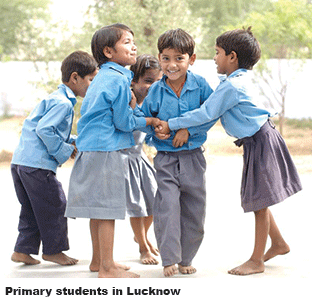 A survey conducted by the district inspector of schools in Lucknow (pop. 3.5 million), the administrative capital of Uttar Pradesh — India’s sprawling and most populous (200 million) state — indicates that one of every six children in government primaries is absent from class for over 49 days per year.
A survey conducted by the district inspector of schools in Lucknow (pop. 3.5 million), the administrative capital of Uttar Pradesh — India’s sprawling and most populous (200 million) state — indicates that one of every six children in government primaries is absent from class for over 49 days per year.
Lucknow district has 12 blocks in which the total number of primaries aggregate 1,369. The number of upper primaries (class VI-VIII) total 427 with the number of students on their muster rolls shown as 134,749 and 42,885 respectively. In the district’s primary schools, 17.85 percent are consistently absent because of family problems such as parents’ illness, responsibility for younger siblings and work on family farms.
Thus, 14,933 or 62 percent of chronic absenteeism is attributed to family pressures. In the district’s 427 upper primaries too, family problems are the main cause of average absenteeism of 45 days per year. On the other hand, health problems, popularly believed to be the major cause of poor school attendance, account for only 22 percent (primary) and 19.42 percent (upper primary) of student absenteeism.
The tiny number of academics and monitors of the education scene in Uttar Pradesh, better known for its caste-ridden politics and pervasive lawlessness, who pay attention to such surveys, are alarmed that these dismal statistics pertain to UP’s admin capital which the state’s young chief minister Akhilesh Yadav showcases as a model city and district. Quite obviously little has changed since a pre-millennium (1998-99) National Family Health Survey II indicated that against the national average of 5.5 years of schooling in India, in Uttar Pradesh it was 4.8 years.
Comments Sarvendra Vikram Singh, director of the State Commission for Educational Research and Training (SCERT): “These statistics show that there’s widespread skepticism about the quality of education dispensed in government schools. No amount of free uniforms, free books and free meals will make up for this basic lack of trust.”
Perhaps more worrying is that “family issues” which keep children away from classes, fall most heavily upon girl children who are routinely entrusted with household chores and made to mind siblings rather than encouraged to attend school.
Typically, instead of addressing the core issues of pathetic infrastructure, slapdash curriculums and mass teacher absenteeism in UP’s 221,653 government schools, the state government has opted for a quick-fix technical solution. It plans to introduce an interactive voice response digital system to monitor the attendance of teachers and students. But IT experts believe this measure is likely to prove ineffective as attendance through voice recognition needs to be recorded by a school staff member who could doctor the recordings.
“Recording attendance through a software-driven system is an example of education ministry officials addressing the symptoms rather than root causes of absenteeism. The question that needs to be urgently addressed is why children and parents shun government schools, and how their attitudes can be changed,” says Rajesh Kumar, chief executive of Lokmitra, an NGO focused on pedagogical improvements in government schools.
The answers to these questions are self-evident to all but Uttar Pradesh’s caste-calculus obsessed politicians, who have a vested interest in the socio-economic status quo.
Puja Awasthi (Lucknow)